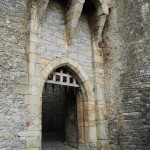Cahir Castle
«…the only famous castle in Ireland,
considered to be impregnable…»
Elizabeth I, XVI century
Cahir Castle, one of the largest castles in Ireland, is sited on an island in the river Suir, in Cahir town center, Tipperary. The castle played not the least role at all at the time of Ireland’s wars for independence and was strategically situated between the cities of Waterford and Limerick. The castle is well preserved, which is due more, however, to the fact that at the time of sieges it surrendered without fighting for this reason or that. At the present time the castle is open for tourists.
Cahir Castle was built in Tipperary in 1142 by Conor O’Brian, the prince of Thomond, – one of the kingdoms that existed in Ireland until the invasion of Normans. Cahir Castle (Irish: Cathair Du’n Iascaig, which means “stone fort of the fish”) provided communication between Waterford and Limerick.
In 1375, the castle was granted to James Butler, newly-created Earl of Ormond who was also called “the foreigner,” for his loyalty to Edward III. During the Nine-year war in Ireland (1594-1603) the Butlers sided with the Irish and fought against England.
In 1599, the castle was captured after a three day siege by the army of Robert Devereux, the 2nd Earl of Essex.
During the Irish Confederate Wars in late 1640s the castle was besieged twice. In 1647, George Mathew, the guardian of the young Lord Cahir, surrendered to Baron Inchiquin following his victory at the battle of Knocknanauss. In 1650, he surrendered again to Oliver Cromwell without a shot even being fired.
In 1840s, Richard Butler decided to restore the castle of his ancestors; yet he ran into debt, and the caste had to be sold. In late 1870s, Lady Margaret Butler Charteris bought the castle back and had some restoration work done.
In 1961, the last Lord Cahir died and the castle got into possession of the Irish state.
At the present time the castle is open for tourists.
The castle consists of three major parts that reflect different phases of its development. The highest part of the island is occupied by the old castle of XIII century. High towers on the corners encircle the inner court of the castle while the truly huge gates once faced the southern part of the island, which at that time was not fortified.
On the north-western corner is a three-storey donjon, which, probably, was the very first fortification on the island. In the donjon there were toilets and private rooms built for the Lord. From the donjon through spiral stairs one can get into an interesting neighboring round tower, which protected the castle from the waters of Suir.
In XV century, James Butler changed the castle in the way that the main residence of the Lord was above the gates into the castle. The latter were blocked, and the entrance was moved eastward. A square outer court with two little towers on the corners was also built, which guarded the remaining part of the island.
In XVI century, the Lords of Cahir built an extra wall between the inner and the outer courts. Thus, the new space was named the middle court.
After the castle was damaged from a siege in 1599, it was almost never restored; only in 1840s the central hall of the castle was rebuilt by Richard Butler.
Tipperary is one of the first Irish counties and was founded in XIII century, so sometimes it is even called “the Premier County.”
The Cahir town was one of the first towns, to which one could come by a “scheduled” stage-coach. In 1800s, Charles Bianconi started regular stage-coaches between the towns of Clonmel and Cahir.
Cahir is the Irish Cristian name of Saint Cahir who was a little-known saint of the region of Donegal in Ireland. This name probably originated from the Gael (a special language of Scotch Celts) name of general Cathair or Cathaoir. In the castle’s museum one can see a miniature “the seizure of the Cahir castle in 1599” consisting of 1000 figures of soldiers.
The information is taken from the Internet resource:
http://www.allcastles.ru/ireland

